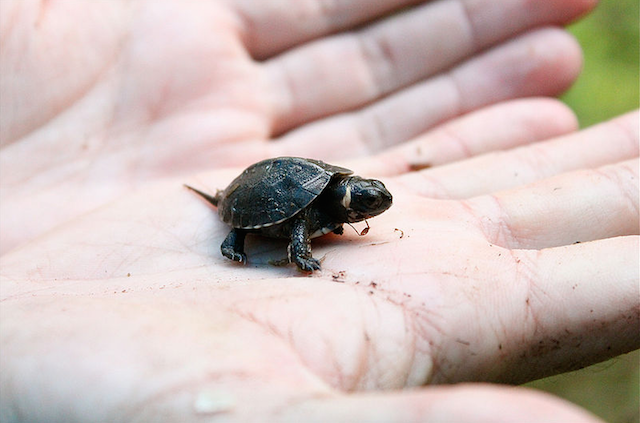As garden club members, we are expected to preserve our natural environment and heed the effects of our actions on native species. To this end, it seemed a good idea to look at Carroll County specifically to see what animals and plants show up on our Endangered Species List.
This first post on that subject comes courtesy of a friend’s comment as we were on our way from Reisterstown to Leisters Church Road as we were traveling along on the Bypass. I remarked that I had hardly been out on Rt. 30 except on the old section between Manchester and Hampstead and gosh, hadn’t they done a nice job with the roadside plantings. My friend said, “Yes, they did. But it took forever to get this road built on account of the Bog Turtles.” My ears perked up; I recalled that name on our Carroll County Endangered List.
The Bog turtle (Glyptemys muhlenbergii) is listed as somewhere between Endangered and Critically Endangered. An 80% decline over 3 generations has been noted.
- Why?
1. Its native habitat is away from large water bodies—inland shrubby swamps, meadow seeps, small spring fed lands. These areas are often ephemeral due to native and invasive plant succession and the temporary nature of water flow. So, already, their small habitat is fragmented and changing. It is difficult to replicate their needs, they are challenging to relocate.
2. Humans who drain wetlands and farm fields accelerate this turtle’s habitat loss. Human action also introduces sediment and ag-chemical runoff into the waters used by the Bog Turtle.
3. The females lay less than 4 eggs, so critical numbers are needed for reproduction and sustainability. They have to reach at least 6 years of age to reproduce.
4. The pet trade has collected large numbers; it’s small and attractive. This contributed to numerical loss.
5. Raccoons are significant predators.
6. Disease is contributing to die-off.
7. They are hit by vehicles while crossing roads that go through their habitat.
- THE BYPASS
The Rt. 30 Bypass was conceived as a way to avoid congestion made worse by I-795. There were a number of reasons for postponement ( including pollution, politics ), but one stoppage resulted from the discovery of endangered Bog Turtles on the proposed route in 1994 which lead to a new route change. Then, in 1998, their habitat found to be much larger than anticipated. The Next Solution: MDSHA put tunnels under the bypass for turtles to use to avoid being hit by cars. Goats were employed to eat invasive species that were contributing to turtle habitat loss.




